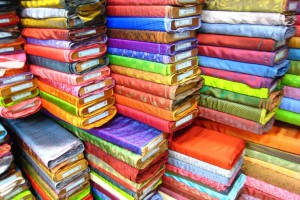
Vibrant, colorful textiles have indeed made our world a brighter place to live in. Most of us will be aware that the existence of these colorful textiles has been made possible through the usage of textile dyes. The dyes seep into the cloth changing it chemically and causing the color to remain there permanently in spite of continuous use.
Origin of Textile Dyes
The number of textile dyes in use today amount to a figure in thousands; with different dyes working effectively on specific types of fabric. The origin of these dyes can be traced to ancient times and since then dyes have come a long way to be what they are in today’s times. Dyes that first originated from nature came to be manufactured in labs and today a large number of dyes in use relate to manmade dyes. Today, mass-manufactured fabrics obtain their color through the use of manmade chemical dyes and usage of natural dyes has almost become a rarity.
Requirement for Large Quantities of Water & Resulting Pollution
It is very true that manmade dyes are largely responsible for lending vibrant colors to the clothes you don everyday but they are also a cause for many problems; pollution being one of the biggest ones! The dyeing process uses large quantities of water and this water is discharged back into the environment without being effectively treated in most of the cases. Besides consuming huge water stores, the lack of effluent treatment plants has led to the polluting of water-bodies like rivers, streams etc.
Affecting Plant & Human Life
Aquatic life is affected deeply as effluents from dyeing plants get emptied into the water-bodies. Dyes contain elements that seriously affect photosynthesis thus reducing the availability of nutrients to plants. Anti-microbial substances which do not biodegrade are commonly used in the dyeing process adding to the pollution of waters.
Not all is Lost
In spite of the above issues, there is still hope for a better scenario. The awareness and responsibility of textile dyes manufacturers has increased. A large section of them are exploring ways and means to reduce the ecological footprint of their business. Manufacturing of dyes that have a low ecological impact has to be given importance. These do not contain heavy metals or harm causing chemicals. Biodegradable dyes and fiber reactive dyes are the best options. Using iron in place of cobalt and chromium that are complexed with metallic azo dyes is a preferred option for prevention of pollution. Development for treatment of dye effluents has to be given the required thrust in this scenario. Some of the current methods in use include biological treatment, incineration and absorption to solid matrices; however, continuous research for better techniques has to be undertaken. And it is quite heartening to know that research is ongoing for developing more effective treatments to reduce the impact of the dye effluents on the environment.
The place of dyes and pigments in today’s world is undisputable. It is therefore the major responsibility of textile dyes manufacturers and all the sub-sets of the family like reactive dyes manufacturers, phthalocyanine pigments manufacturers and many more to take greater positive steps in this direction.